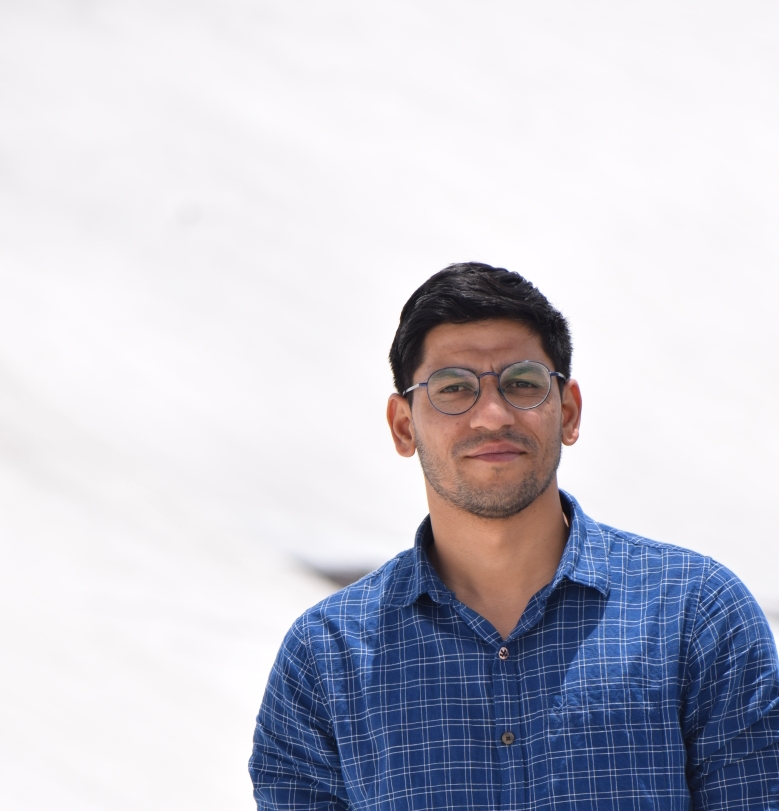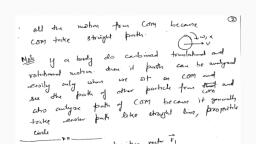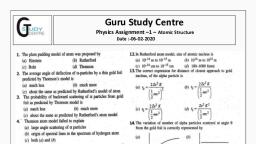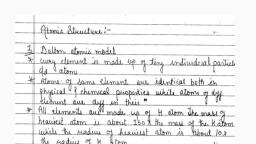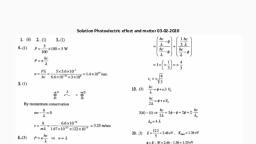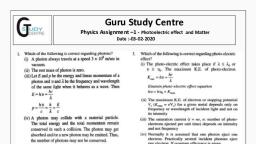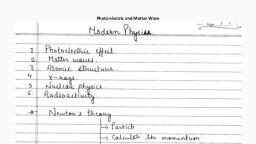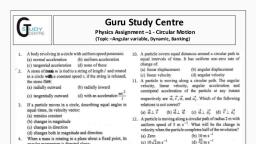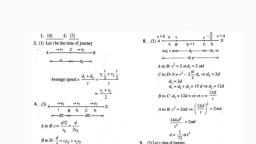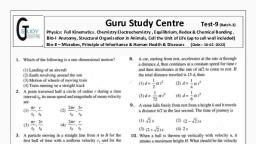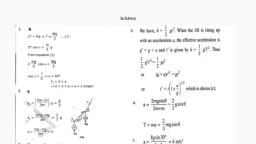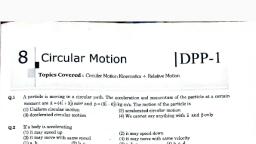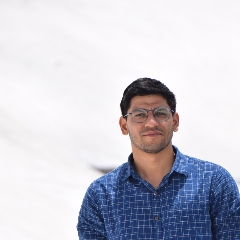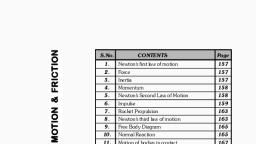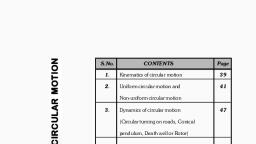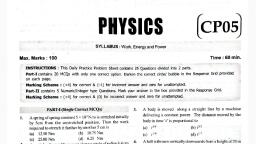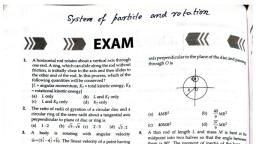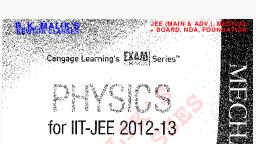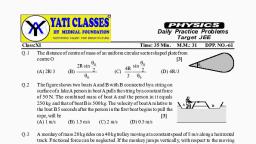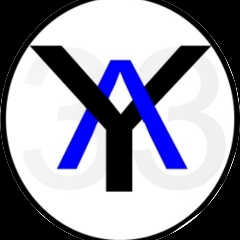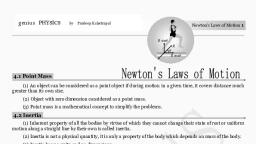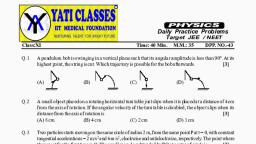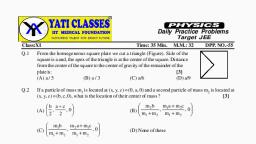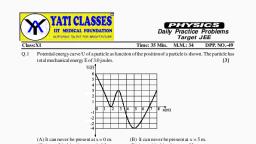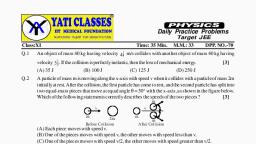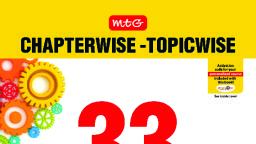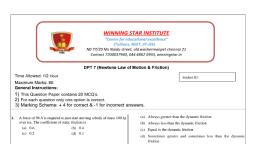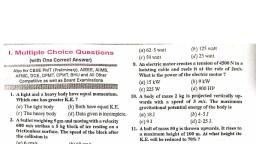Page 1 :
In the given figure, pulleys and strings are, massless. For equilibrium of the system, the, value of u is , , , (A) 60°, (c) 90° (D) 120°, , In the figure, the blocks A, B and C each of, mass m have accelerations a,, a2 and a3, respectively. Fy and F2 are external forces of, magnitude 2 mg and mg respectively. Then , (B) 30°, , Fy=2mg Fz=mg, , (A) a, = a2 = a3 (B) a, > a3 > a2, (C) a, = 82,82 > a3 (D) a, > a2, a, = a3, , A lift is moving in upward direction. The total mass of, the lift and the passengers is 1600 kg. The variation of the, velocity of the lift is as shown in the figure, The tension, in the rope at ¢ = 8" second will be, , , , Vet, (mis), 3 6 10 Xs), (1) 11200 N (2) 16000 N, (3) 4800 N (4) 12000 N, , A block, released from rest from the top of a smooth, inclined plane of angle of inclination @,, reaches the, bottom in time 4,. The same block, released from, rest from the top of another smooth inckined plane of, angle of inclination @,, reaches the bottom in time f,., If the two inclined planes have the same height, the, relation between f, and f, is, , * v2, @ 4.( S20) @ 2, 4, \sin@, 4, sin’@,, fh _ sind, he, aes @ 2-1, , A person standing in a stationary lift drops a coin, from a certain height A. It takes time ¢ to reach the, floor of the lift. If the lift is rising up with a uniform, acceleration a, the time taken by the coin, dropped, from the same height A, to reach the floor will be, , (a)t * (b) 2, &, , 2 m a 2, w+ (1+4) (1-2), g g, , QP, 6. & [es Pay Caleulate a & T., , , , sind, (ly am meet (2 028 meee, 3) asain ae) tne, , Calculate a & T., , , , (1) az4 m/sec’, T=8N, (3) a4 m/sec’, T4N (4) None, , (2)a=2 m/sec’, T=8N, , 8. A boy standing on a weighing machine notices, his weight as 400 N. When he suddenly jumps, upward, the weight shown by the machine, becomes 600 N. The acceleration with which, the boy jumps up is :, (1) 5 ms (2) 3.4 ms*, (3) 6 ms? (4) 9.8 ms*, , 9. — Ifimpulse / varies time t as (kg ms“) = 20 ?- 401., The change in momentum is minimum at :, ()t=2s @t=1s @t=5s (r=3s, 10. Block A of mass 4 kg is to be kept at rest, against a smooth vertical wall by applying a, force F as shown in figure. The force required, , , , is - (2 = 10 m/s?), a5, F, (1) 40V2N (2) 20/2N, G) 10V2N (4) 1sV2N, , 11. Three blocks are placed as shown in figure., Mass of A, B and C are m,, m,, and m,, respectively, The force exerted by block 'C’ on, , , , ‘B' is :Q) mg (2) (m, + m,)g, (3) mg (4) (m, +m, + m,)z
Page 2 :
12., , 13., , 14., , 15., , 16., , bY Ay, , 18., , In the system shown in the figure, all surfaces are, smooth. Block A and B have mass m each and, mass of block C is 2 m. Ail pulleys are massless, and fixed to block C. Strings are light and the force, F applied at the free end of the string is horizontal., Find the net force on block c, , , , , , , , , , 8, A c, F, . 19., (1) Zero - (2) (2m + m)a, (3) 4ma (3) None, In the above questions. Find the value of, acceleration on block A ?, C) F/4m (2) F/2, (3) F/2m (4) None 20., , A pendulum has a bob connected to a light wire,, Bob ‘A’ is in equilibrium in the position shown., The string is horizontal and is conntcted to a, block B resting on a rough surface. The block B is, on verge of sliding when @= 60°., , , , , , , , , , , , verre, , If@Increases to 70° and, , “'m’ is mass of bob then, (1) block will slide, , (2)block will not slide 21., (3) block is in equilibrium, (4) None, , 22,, In the above questions., With @ = 60°, calculate the ratio of tension, ini the pendulum wire immediately after the 23., , string is cut to the tension in the wire before, the string is cut., , G) 1/4 (2) 1/2, , (3) 4/1 (4) None, , A block slides down a frictionless plane inclined, at an angle @. For what value of angle @ the, horizontal component of acceleration of the block, , is maximum?, , (1) 90° (2) 180°, , (3) 45° (4) None, , Tn above question, find the maximum horizental acceleration?, (1) 9/2 (2) 2g, , @a (4) None, , In the given arrangement, all strings and pulleys, are light. When the system was released it was, observed that M and my do not move. Find the, masses M in terms of m, and m., , 4m,m2, my +m, , (), , gq “am, m,+m,, @) Bm ,mMz, , m,+m2, , (4) None, , m\|, m, , In the above question, find mo, (i Aare @ nw., m,+m2 m,+m2, , @) Same (4) None, my,+m2, , ‘The system shown in the fig. is in equilibrium., Pulleys A and B have mass M each and the block, C has mass 2M. The strings are light. There is an, insect (D) of mass M/2 sitting at the middle or the, right string. Insect does not move., , , , the tension in S, is, (1) equal to (9/2)Mge, (2) more than (9/2)Mge, (3) less than (9/2)Mge, (4) None, , In the above question, Find tension s,, (1) 5 Mg (2) 21g (3) Me (4) None, , '- Find tension in S2 if the insect flies and sits, , at point E on the string., , (2) 4 (2)5Mg (3) Ma (4) None, ., , . Three blocks A, B and C are placed in an, , ideal Atwood machine as shown in the, figure. When the system is allowed to move, freely it was found that tension in the string, connecting A to C was more than thrice the, tension in the string connecting A and B. The, masses of the three blocks A, B and C are m,., mz and my, respectively, Which of the, , following is true [All masses have finite’ non, zero values and the system has a non zero, acceleration]., , (1) mi>2 me, (2) mi<2 me, (3) ma>2 mi, (4) me < 2m:, , nla], , m| 8
Page 3 :
24,, , 26., , 27., , A person of 40 kg is managing to be at rest, between two vertical walls by pressing one wall, A by his hands and feet, and B with his back, Fig, 4.24. The coefficient of friction between. his body, and the wall is 0-8. The normal force exerted by, the person is, , (a) 250N (b) 200N, (c) 100N (@ 125N, . Consider the situation as shown in the figure. Choose the, correct option. ., 205 F=10N, , (1) The friction force on the block is | N if m=0.1 kg, (2) The friction force on the block is 5 N if m= 1.0 kg, (3) Both (1) and (2) are correct, , (4) Both (1) and (2) are incorrect, , A block of mass m is in contact with the cart C as shown., The coefficient of static friction between the block and the, cart is 1. The acceleration a of the cart that will prevent, , the block from falling satisfies, —a, (ac % 2) a> ™8, u Hu, 8 g, 3)a<— 4 =, Ga jim War, , A car starts from rest to cover a distance s. The, coefficient of friction between the road and tyres is, }. The minimum time in which the car can cover, the distance is proportional to, , 1 1, On OF wy, , (@) p, , 28. A person is sitting facing the engine in a moving, , train. He tosses a coin. The coin falls behind him., This shows that the train is, , (a) moving forward with a finite acceleration, , (b) moving forward with a finite retardation, , (c) moving backward with a uniform speed, , (d) moving forward with a uniform speed., , 31., , Fig. shows a uniform rod of length 30 cm, having a mass of 3-0 kg. The strings shown in the, figure are pulled by constant forces of 20 N and, 32 N. Find the force exerted by 20 cm part of the, rod on the 10 cm part. All the surfaces are smooth, , , , , , , , , , and the strings and the pulleys are light., F F, ony 10cm! 20cm Pt, (a) 36N (b) 12N, (c) 64N (d) 24N, Consider the situation shown in Fig. The, acceleration of block of mass m is, , , , (a) g/3 up the plane —(b)_g/3 down the plane, (c) g/2 up the plane (d) _g/2 down the plane, An insect crawls up a hemispherical surface very, slowly, Fig. . The coefficient of friction between, the insect and the surface is 1/3. If the line joining, the center of the hemispherical surface to the insect, makes an angle o with the vertical, the max., possible value of a is given by, , (a) cota=3, (b) sec a=3, , (ce) cosec a= 3, (d) None, , , , Two blocks A and B each of mass m are placed on a smooth, horizontal surface. Two horizontal force F and 2 F are, applied on the blocks A and B respectively as shown in, figure. The block A does not slide on block B., , , , Then the normal reaction acting between the two blocks is, F F, , @F m= ¢ d) 3F, 2 15 (a)
Page 4 :
33,, , 34., , 35., , 36., , 37., , 38., , 39., , Cc, D, , Column-I Column-II, Aeay esp ey, A+BI=|A-Bl P 30°, AxBl=A-B Q 4s, +4, A B= ABI2 R 60°, Ax B= AB/2 Ss 90°, , (a) A-P, B-Q,C-R, D-S_ (b) A-Q, B-P,C-R,D-S_— (c) A-R, B-S,C-P,D-Q_— (d) A-S, B-Q, C-R, D-P., , The condition under which the vectors (a + b) and (@ ~ 5) should be at right, angles to each other is ., , (a) aeb (b), (c) [a@l=1b1 (d) a:, , ', , ro, u, , 0, =1, , The vector sum of three vectors @, 5 andZ is zero. If i and j are unit vectors, in the directions of d and 6 respectively, then, , (a) @ is in the plane of j andj (b) @ is along (ix j), (c) € is along i - (d) @ is along j, The two vectors A and B that are perpendicular to each other are, (a) A= 3i+3j+2k, B=2i-2j+k, (0) Am 2i+3j+2k, ; ‘ B=2i-2j+k, (c) Am2i-3j+ 2k, B=2i-2j-k, (4) Ami+3j+2k, B=21-2j+k, The two vectors A and B that are parallel to each other are, () A= 3i+6j+9%, B=i+2j+3k, (b) A= 31-6)+9k, B=i+2j+3k, (c) A=2i+3)+3k, B=i+2j-3k, (d) A=21+6j-9k, B=i-2j-3k, , If @=21-3}+k and 5 = 3i+j- 2k, the cosine of angle @ between them, is equal to, (@) 54 =) ITs) 14S (d) AN, , If none of the vectors A,B and are zero and if Ax B = Oand BxC =0,, , the value of Ax € is, (a) unity (b) zero, , (c) B?, , (d) AC cos 6
Page 5 :
40.., , 41,, , 42., , 43., , . A scooter is going towards cast at 10 ms_, , A scalar triple product (A x B)- € vanishes when, (a) A, Band € are not in the same plane (b) A, Band are in the same plane, (c) € is perpendicular to both AandB (4) B is perpendicular to both A and C, , The value of p so that the vectors 2i- j+,i+2j-3k and 3i+pj+5k, en monte te, , a)’ 16 (b) -4, , © 4 (@) -8, , ie A=i+j+k, B=214+3], G=31+3j-2k and D=-3j]+k, then, , a >, , AB and CD are, , (a) equal in magnitude and direction, , (b) equal in magnitude only, , (c) perpendicular to each other, , (d) parallel to each other, , ‘ turns right, through an angle of 90°. If the speed of the scooter remains, unchanged in taking this turn, the change in the velocity of, the scooter is:, , (a) 20.0m s~! in south-western direction, (b) zero, (c) 10.0m s~! in southern direction, , (d) 14.14 ms~! in south-western direction, , , , If A, B and Care three vectors, th@n th a oe, relation is - . ne 45. Stat@liyent I : =x and V4ixo, (A) A+ (B+C) =(A+B)+€ St@temerfti] : Cross product is commutative., , B)A.(B+C)=(A.B)+A6 4 soe, acmeorareaee 46. StagEmegt I : When P+Q=R andP+Q=R,, , (D) (Ax B). C= Ax (B.C) the angfe between p & Q must be 02,, , * pesartton Reason Type Questions: Statément IT: Here 0 = 0°, , Each of the questions given below consist of WE fo? 07s 2PQeas0" = P+ Q., , Statement - I and Statement ~ IT. Use the sap ,, following Key to choose the appropriate 47. Statement-1 : If three vectors A.B and ¢, answer,, , satisfy the relation AB=0 & A.C=0 then, (A) If both Statement- Land Statement- IT, , are true, and Statement - LT is the correct the vector j is parallel to 8x¢explanatior of Staterent~ I. Statement-2 : ALB and ALG hence Ais, (B) If both Statement - Iand Statement - ; !, , Tl are true bat Statement - II is not the perpendicular to plane formed by § and¢, Correct explanation of Statement ~ I. 48. Statement-1 : The minimum number of, (C) If Statement - 1 true but Statement - vectors of unequal magnitude required to, Tlis falsey produce zero resultant is three. ‘, (D) If Statement 1 is false but Statement Statement-2 : Three vectors of unequal, -Ilis tree, magnitude which can be represeted by the, , three sides of a triangle taken in order, produce, Zero resultant.
